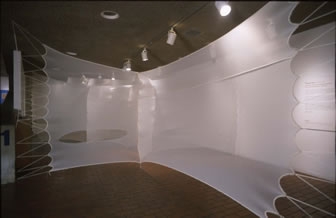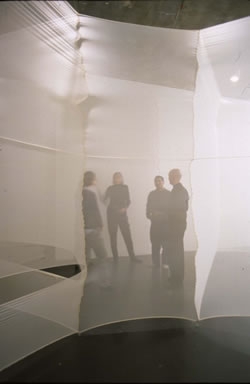Feature: Reviews
Ernesto Neto
- Berkeley Art Museum
- Berkeley, CA
- February 18 - April 15, 2001
A Maximum Minimum Time Space Between Us and the Parsimonious Universe at the Berkeley Art Museum
Ernesto Neto creates installations using stocking-like materials that he sometimes fills with spices, or translucent scrims that he stretches and suspends from the walls and/or ceilings. Visually seductive and enticing (or repugnant) with their often pungent odors, they transport viewers into netherworlds, light and ethereal, or corporeal and heavy. Neto lives, works and was born in Rio de Janeiro, making him a true carioca—someone who it is believed takes great pleasure from his environment. Lately, Neto has received a great deal of attention, allowing him to place his pleasurably sensual environments in museums and exhibition spaces worldwide.
A focus on the corporeal and sensual realm of aesthetic experience as well as an interest in interactivity has an established lineage in Brazil with Hélio Oiticica and Lygia Clark at the forefront in the1960s. Both were recently included in the influential exhibition The Experimental Exercise of Freedom at the Museum of Contemporary Art in Los Angeles. Brazilian artists have long been exhibited in Europe and in New York and vice versa (Neto cites European Modernism as well as Alexander Calder, Constantine Brancusi, and Richard Serra among his influences).
Matrix curator Heidi Zuckerman Jacobson says that she has been enjoying Neto’s work ever since she saw (and smelled) his first solo show at Tanya Bonakdar gallery in New York.
“I love the way that he does not prioritize sight as the primary sense in the viewing of/interaction with his work. While his installations function as beautiful sculptures, I appreciate that they are a tactile and sometime olfactory experience as well. I also enjoy that they often give the viewer a “time-out” in a day of viewing art, i.e. a place to have your environment shift.”
For Matrix Exhibit 190, Neto stretches white translucent fabric between the acute angles of the Berkeley Art Museum’s concrete gallery space, attaching the membrane to the walls with zigzags of white rope and hardware. The material is divided into a series of connected rooms or chambers. Neto cut slits in the cloth, creating vaginal or paramecium shaped doorways where visitors could enter and exit, migrating through the airy and mysteriously shrouded space. Visitors were told to remove their shoes before entering, heightening the sense of transformation — of entering another land — as well as protecting the fragile white fabric from dirt and pulls.
In his slide talk at the San Francisco Art Institute, Neto noted that he is engaged in investigating the body: “how what is in one’s head is translated to one’s hand and how what goes into your mouth becomes something else.” For Neto, the fabric (or the actual fabrication of a piece) becomes a metaphor for alimentation (the act or process of affording nutriment or nourishment): He builds cells out of the stretched fabric, pushing and pulling and shaping the cell cocoons into satisfying and sophisticated constructions. Neto’s interests also lie in the intersections of environments and experiences, and of the mind and body. A wonderful conflation of these ideas as well as the breakdown between art and life occurred last year when he was married in one of his multi-chambered installations at the Museum of Modern Art in Rio de Janeiro.
All in all, however, A Maximum Minimum Time Space Between Us and the Parsimonious Universe was a bit of a letdown. During the artists’ talk at BAM Neto revealed that there was a problem translating the measurements for this installation and that the calculations were off. Also, the cold angularity of the Matrix space seemed to disrupt rather than enhance the curves of the work, perhaps also accounting for the not quite rightness of this particular piece.
Or, perhaps it has to do with expectations — with Neto you expect over the top sensation (not in the British sense, but in the five senses sense) and a feeling of complete surrender to the experience. While it was interesting to move around the chambers of this piece, and the fabric was cool and evocative, I never felt that I got beyond that crazily shaped Matrix space. I was not totally seduced and did not succumb to the installation, essential components of the most successful of Neto’s work. Nonetheless, West coast viewers can only hope that this trend of showing strong, aesthetically challenging work from Brazilian artists such as Clark, Oiticica and Neto as well as his compatriots Tunga, Cildo Meireles and many more will continue.
Ernesto Neto - A Maximum Minimum TimeSpace Between Us and the Parsimonious Universe ran February 18 through April 15, 2001 at the Berkeley Art Museum. For more information about this show, other Matrix artists and exhibitions seewww.bampfa.berkeley.edu.


